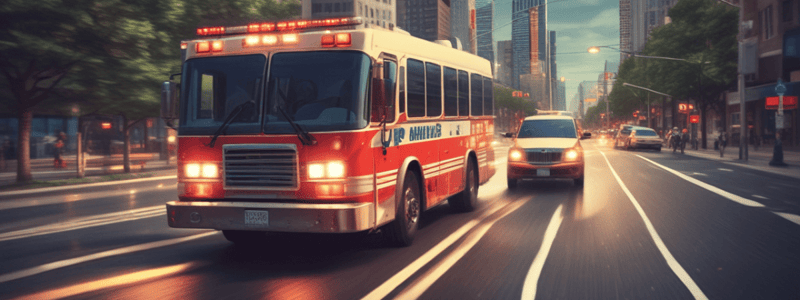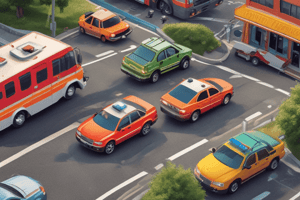Podcast
Questions and Answers
What is an emergency vehicle driver allowed to do when using warning lights and sirens?
What is an emergency vehicle driver allowed to do when using warning lights and sirens?
- Drive onto unpaved or grassy areas when the ground has been saturated with rain
- Drive faster than the posted speed limit and travel left of the center to make an illegal pass
- Proceed through a red light or stop sign after stopping and drive against the flow of traffic on a one-way street (correct)
- Make an illegal turn and park or stand in an otherwise illegal location
When is it acceptable to use warning lights and sirens?
When is it acceptable to use warning lights and sirens?
- During a true emergency call (correct)
- When driving to a non-emergency call
- During a routine patrol
- When traveling on unpaved roads in rural settings
What should you avoid assuming when driving with warning lights and sirens?
What should you avoid assuming when driving with warning lights and sirens?
- That lights and sirens will always get you to the scene quickly
- That you can drive through congested areas without stopping or slowing down (correct)
- That other motorists will move out of the way
- That you need to drive at a lower speed
Why should you leave enough space between your vehicle and the one in front of you?
Why should you leave enough space between your vehicle and the one in front of you?
What should you do when approaching intersections?
What should you do when approaching intersections?
Why should you be cautious of unpaved roads in rural settings?
Why should you be cautious of unpaved roads in rural settings?
What should you instruct your family members to do when driving behind you?
What should you instruct your family members to do when driving behind you?
What should you be cautious of when using escorts?
What should you be cautious of when using escorts?
Flashcards are hidden until you start studying
Study Notes
Emergency Vehicle Privileges
- Emergency vehicle drivers have limited privileges, but these privileges do not reduce liability in case of a crash.
- The use of warning lights and sirens allows drivers to:
- Park or stand in an otherwise illegal location
- Proceed through a red light or stop sign after stopping
- Drive faster than the posted speed limit
- Drive against the flow of traffic on a one-way street
- Make an illegal turn
- Travel left of the center to make an illegal pass
- Right-of-way privileges vary from state to state and should only be used when absolutely necessary.
Operating with Warning Lights and Sirens
- The unit must be on a true emergency call to use warning lights and sirens.
- Both audible and visual warning devices must be used simultaneously when taking exemption to traffic laws.
- The unit must be operated with due regard for the safety of all others around us.
Safe Practices
- Avoid assuming that lights and sirens will allow you to drive through congested areas without stopping or slowing down.
- Use escorts with caution, as many drivers may only see the first set of lights and assume the way is cleared.
- Leave enough space between your vehicle to react if someone pulls in front of you unexpectedly.
- Use a different siren tone than that of the first vehicle to alert motorists that a second vehicle is approaching.
- Instruct family members not to drive closely behind you and to know how to get to the hospital at a slower speed.
Special Situations
- When approaching intersections, look for other motorists and pedestrians before proceeding.
- When traveling on unpaved roads in rural settings, operate at a lower speed and keep a better grip on the steering wheel.
- Avoid driving onto unpaved or grassy areas when the ground has been saturated with rain, as there's a good chance the vehicle will get stuck.
- Be cautious of other people entering the roadway, including animals.
- When traveling around school buses, never pass a school bus that has stopped to load or unload children or that has a stop arm extended.
- When approaching school zones, be visible and keep a lookout for children moving to the road.
- In many states, it is not legal for an emergency vehicle to exceed the speed limit in school zones.
- Proceed through school zones at the posted speed limit.
- When approaching funeral processions, most states offer no exemption, so turn off audible devices out of respect.
Emergency Vehicle Privileges
- Emergency vehicle drivers have limited privileges, but these privileges do not reduce liability in case of a crash.
- Warning lights and sirens allow drivers to:
- Park or stand in illegal locations
- Proceed through red lights or stop signs after stopping
- Drive faster than the posted speed limit
- Drive against the flow of traffic on a one-way street
- Make illegal turns
- Travel left of the center to make an illegal pass
Operating with Warning Lights and Sirens
- The unit must be on a true emergency call to use warning lights and sirens.
- Both audible and visual warning devices must be used simultaneously when taking exemption to traffic laws.
- The unit must be operated with due regard for the safety of all others.
Safe Practices
- Avoid assuming that lights and sirens will allow you to drive through congested areas without stopping or slowing down.
- Use escorts with caution, as many drivers may only see the first set of lights.
- Leave enough space between your vehicle to react if someone pulls in front of you unexpectedly.
- Use a different siren tone than that of the first vehicle to alert motorists.
- Instruct family members not to drive closely behind you and to know how to get to the hospital at a slower speed.
Special Situations
- When approaching intersections, look for other motorists and pedestrians before proceeding.
- When traveling on unpaved roads, operate at a lower speed and keep a better grip on the steering wheel.
- Avoid driving onto unpaved or grassy areas when the ground has been saturated with rain.
- Be cautious of other people entering the roadway, including animals.
- When traveling around school buses, never pass a school bus that has stopped to load or unload children.
- When approaching school zones, be visible and keep a lookout for children moving to the road.
- In many states, it is not legal for an emergency vehicle to exceed the speed limit in school zones.
- Proceed through school zones at the posted speed limit.
- When approaching funeral processions, turn off audible devices out of respect.
Studying That Suits You
Use AI to generate personalized quizzes and flashcards to suit your learning preferences.




